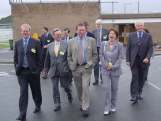Brian Wilson, the UK Minister for Industry,
energy and Environment and Wendy Alexander, the Scottish Executive
Minister for enterprise and Lifelong Learning visited Dounreay today
Thursday 30 august 2001. Their visit followed discussions in
Thurso with senior figures from the highlands and Islands Enterprise
Network about the potential for economic development arising from the
decommissioning opportunities at Dounreay.

Ministers At
Dounreay
The ministers want to put Dounreay at
the heart of a world class decommissioning industry and see the
potential in building up the expertise of the population similar to that
which has already happened in Grampian around the oil and gas
industries. The ministers toured the site and met local economic
development agencies, senior management and trade unions to discuss
future prospects.
Brian Wilson stressed that the decommissioning project was the largest
of the decade and that large benefits could accrue to Caithness, the
Highlands and the whole of Scotland. Whilst agreeing that many of
the major contracts would go to some major world class firms there was
plenty of work and contracts that should be available to local Highland
firms especially as sub-contractors.
the UKAEA estimates the work will take
50 - 60 years to completely decommission the site at a cost of �4
billion. Over the next 20 years up 20 new plants will need to be
built to treat a legacy of radioactive materials and wastes creating
substantial additional employment opportunities during
construction. There was huge potential in the next few years
as many aspects would be front loaded with high spends in the early
years of the programme. Dounreay could be an undisputed force for good
with benefits all round. Wendy Alexander saw Caithness as having the
chance to become expert in decommissioning.
Neil Money To Lead New Task Force
The importance of the project was reflected
in her announcement about Neil Money stepping down as chief Executive of
Caithness and Sutherland Enterprise to take on responsibility for the
new HIE Network Dounreay Decommissioning Strategic Response Task
force. Other members of his team will be announced later.
Neil money said later that the decommissioning was the greatest
opportunity ever for Caithness - possibly even greater than the
development of Dounreay itself. The chance to develop a new area
of expertise leading to numerous possible spin offs for Caithness and
the Highlands. His job would be to try to make sure that the
opportunities were realised. Neil Money has been on 6 month
secondment studying the possible economic aspects for Caithness and the
highland economy.
The Past
In 1988, when Cecil Parkinson announced the closure of the fast reactor
in 1994 and the fast reactor reprocessing plant in 1997, it was
predicted that jobs at Dounreay would drop from 2110 to 530 and
unemployment in Thurso would rise to 36.7 per cent.
What happened? The
Government allowed UKAEA to make up the loss of state funding by using
its plants for commercial work in fuel fabrication and
reprocessing. Nevertheless,
total employment at the site did fall to as low as 1100.
UKAEA concluded the business was not viable and in 1998 Donald Dewar and
John Battle announced that no more commercial reprocessing would be
sought at Dounreay.

Looking
at The Current Set Up
The decision allowed UKAEA to focus on
what needed to be done to decommission the site. Shortly afterwards, NII
and SEPA carried out a safety audit and made 143 recommendations. One of
them was that too many staff had been allowed to leave and not been
replaced; another was the need for an integrated decommissioning plan
for the site.
Staff Increases
UKAEA started a major recruitment drive to undertake the decommissioning
work and in October 2000 published the integrated site restoration plan,
which describes some 1500 interdependent projects required to
decommission the site. Employment levels at Dounreay have risen to 2000
people, with about 1000 working for UKAEA and 1000 for contractors.
UKAEA has recruited 250 staff since 1998 and is recruiting an additional
200 staff this year.
The site restoration plan envisages the
level of employment remaining steady at more than 2000 for the next 15
years or so. Spending at Dounreay is now running at �140-150 million a
year, almost double the level during the mid-1990s. Of this, some �61
million is injected into the Caithness economy (�23m in net salaries,
�4m in pensions, �4 million in contracts and �30m in sub-contracts).
UKAEA estimates it will take 50-60 years
to completely decommission the site at a cost in the region of �4
billion. Over the next 20 years, up to 20 major new plants will need to
be built to treat a legacy of radioactive materials and wastes, and this
will create substantial additional employment during construction. All
major radiological hazards should be dealt with by 25 years, after which
spending and jobs will decline.
Unemployment Lowest in Living Memory
in Thurso Area
Unemployment in Thurso now stands at 3.1 per cent ? the lowest level in
living memory and is falling. House prices are rising rapidly as
skilled staff and their families migrate to Caithness, although the
perception in the south that Dounreay is closing down can be a deterrent
to recruitment.
Population Stabilised
Caithness (pop. 26,000) had faced serious demographic problems during
the 1990s and was alarmed by forecasts that out-migration would lead to
the loss of 30 per cent of young people by 2015 or so. Dounreay is now
being marketed as a career opportunity for young people once again. The
Local Plan published by Highland Council predicts significant
socio-economic growth in Thurso as a result of the decommissioning work.
New housing estates, an expansion of the business park and new road
links are proposed. Are local firms benefiting or is all the work going
to national companies?
During 2000/01, Dounreay spent �80
million on contracts. This was divided among companies in Caithness
(�4.2m), the rest of the Highlands and Islands (�0.6m), the rest of
Scotland (�8.5m) and England (�66m). However, Caithness firms also
picked up some �30m in sub-contracts.
Local Firms Can Increase Their Share Of The
Work
Local firms can pick up a larger
share largely through sub-contracts with the big firms who undertake the
major decommissioning projects. The small share of work currently going
to the rest of the Highlands and Islands is another potential growth
area. A good example of a local firm that's thriving is the
engineering company JGC Engineering and Technical Servivces, a
third-generation family firm at Harpsdale which has become a key player
in alliances to decommission both fast reactors at the site. UKAEA
is working closely with HIE and CASE to develop opportunities for firms
in the Highlands and Islands. By building up their strength through
sub-contracting for multi-nationals, other local firms will develop the
potential to export their skills to decommissioning projects elsewhere.

Investment
Investment on the ground is beginning to materialise. Motherwell
Bridge have opened a training centre in Thurso, numerous branch offices
are opening up and Hertel have acquired the former US Navy base at Forss
for contractor support facilities. The French company Framatome, which
is part of the fast reactor decommissioning alliances, are undertaking a
skills transfer with JGC and want to extend their educational
partnership with colleges in France and Germany to the North Highland
College. An off-site trials facilities is also being developed on
the outskirts of Thurso and may provide additional training benefit
through UHI. European funding was secured for the college to run a
"safety passport" training initiative for contractors' staff.
UKAEA Links
UKAEA is developing closer links with the planning and development
department of the Highland Council to:
- Prepare for a spate of major on-site
planning applications expected over next few years
- Understand the socio-economic impact
on the community and local infrastructure.
Local Plan
The new Local Plan recognises that infrastructure, such as roads,
may need improved to enable full decommissioning. UKAEA is preparing an
Environmental Statement and Land Use Plan for the Dounreay Site
Restoration Plan which will detail the impact.
Aspects.
The famous Ball which has been closed for many years will be cleaned up
and this work will take up to 25 years. It is just one part of the
site which will be completely restored and made safe.

The ministers later visited the Battery Factory
just outside Thurso where another new contract has just been announced.
|
